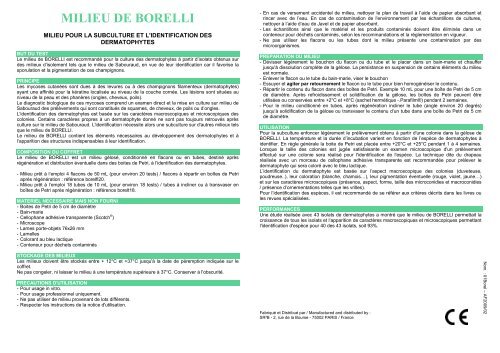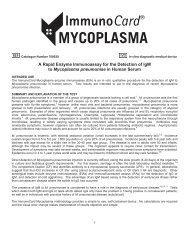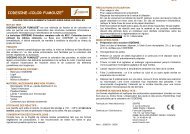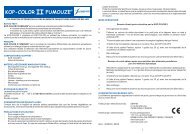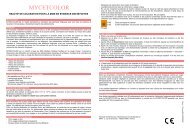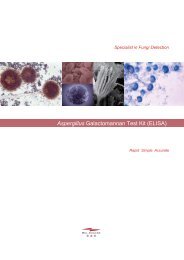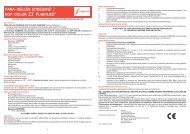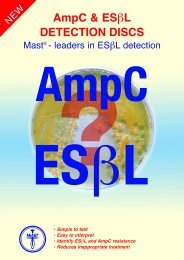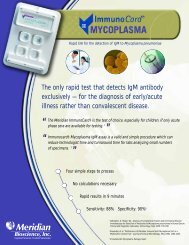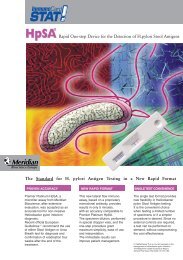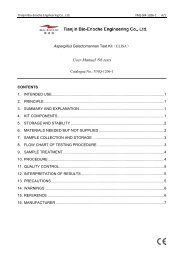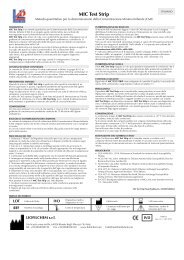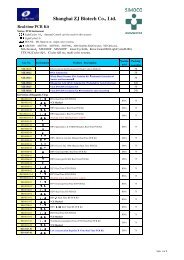MILIEU DE BORELLI - Simoco Diagnostics
MILIEU DE BORELLI - Simoco Diagnostics
MILIEU DE BORELLI - Simoco Diagnostics
Create successful ePaper yourself
Turn your PDF publications into a flip-book with our unique Google optimized e-Paper software.
<strong>MILIEU</strong> <strong>DE</strong> <strong>BORELLI</strong><br />
<strong>MILIEU</strong> POUR LA SUBCULTURE ET L'I<strong>DE</strong>NTIFICATION <strong>DE</strong>S<br />
<strong>DE</strong>RMATOPHYTES<br />
BUT DU TEST<br />
Le milieu de <strong>BORELLI</strong> est recommandé pour la culture des dermatophytes à partir d’isolats obtenus sur<br />
des milieux d’isolement tels que le milieu de Sabouraud, en vue de leur identification car il favorise la<br />
sporulation et la pigmentation de ces champignons.<br />
PRINCIPE<br />
Les mycoses cutanées sont dues à des levures ou à des champignons filamenteux (dermatophytes)<br />
ayant une affinité pour la kératine localisée au niveau de la couche cornée. Les lésions sont situées au<br />
niveau de la peau et des phanères (ongles, cheveux, poils).<br />
Le diagnostic biologique de ces mycoses comprend un examen direct et la mise en culture sur milieu de<br />
Sabouraud des prélèvements qui sont constitués de squames, de cheveux, de poils ou d’ongles.<br />
L'identification des dermatophytes est basée sur les caractères macroscopiques et microscopiques des<br />
colonies. Certains caractères propres à un dermatophyte donné ne sont pas toujours retrouvés après<br />
culture sur le milieu de Sabouraud. L'identification nécessite alors une subculture sur d'autres milieux tels<br />
que le milieu de <strong>BORELLI</strong>.<br />
Le milieu de <strong>BORELLI</strong> contient les éléments nécessaires au développement des dermatophytes et à<br />
l’apparition des structures indispensables à leur identification.<br />
COMPOSITION DU COFFRET<br />
Le milieu de <strong>BORELLI</strong> est un milieu gélosé, conditionné en flacons ou en tubes, destiné après<br />
régénération et distribution éventuelle dans des boites de Petri, à l’identification des dermatophytes.<br />
- Milieu prêt à l’emploi 4 flacons de 50 mL (pour environ 20 tests) / flacons à répartir en boîtes de Petri<br />
après régénération : référence borelfl20.<br />
- Milieu prêt à l’emploi 18 tubes de 10 mL (pour environ 18 tests) / tubes à incliner ou à transvaser en<br />
boîtes de Petri après régénération : référence borelt18.<br />
MATERIEL NECESSAIRE MAIS NON FOURNI<br />
- Boites de Petri de 5 cm de diamètre<br />
- Bain-marie<br />
- Cellophane adhésive transparente (Scotch ® )<br />
- Microscope<br />
- Lames porte-objets 76x26 mm<br />
- Lamelles<br />
- Colorant au bleu lactique<br />
- Conteneur pour déchets contaminés<br />
- En cas de versement accidentel de milieu, nettoyer le plan de travail à l’aide de papier absorbant et<br />
rincer avec de l’eau. En cas de contamination de l'environnement par les échantillons de cultures,<br />
nettoyer à l’aide d’eau de Javel et de papier absorbant.<br />
- Les échantillons ainsi que le matériel et les produits contaminés doivent être éliminés dans un<br />
conteneur pour déchets contaminés, selon les recommandations et la réglementation en vigueur.<br />
- Ne pas utiliser les flacons ou les tubes dont le milieu présente une contamination par des<br />
microorganismes.<br />
PREPARATION DU <strong>MILIEU</strong><br />
- Dévisser légèrement le bouchon du flacon ou du tube et le placer dans un bain-marie et chauffer<br />
jusqu'à dissolution complète de la gélose. La persistance en suspension de certains éléments du milieu<br />
est normale.<br />
- Enlever le flacon ou le tube du bain-marie, viser le bouchon<br />
- Essuyer et agiter par retournement le flacon ou le tube pour bien homogénéiser le contenu.<br />
- Répartir le contenu du flacon dans des boîtes de Petri. Exemple 10 mL pour une boîte de Petri de 5 cm<br />
de diamètre. Après refroidissement et solidification de la gélose, les boîtes de Petri peuvent être<br />
utilisées ou conservées entre +2°C et +8°C (sachet hermétique -.Parafilm®) pendant 2 semaines.<br />
- Pour le milieu conditionné en tubes, après régénération incliner le tube (angle environ 20 degrés)<br />
jusqu’à solidification de la gélose ou transvaser le contenu d’un tube dans une boîte de Petri de 5 cm<br />
de diamètre.<br />
UTILISATION<br />
Pour la subculture enfoncer légèrement le prélèvement obtenu à partir d'une colonie dans la gélose de<br />
<strong>BORELLI</strong>. La température et la durée d’incubation varient en fonction de l’espèce de dermatophytes à<br />
identifier. En règle générale la boite de Petri est placée entre +20°C et +25°C pendant 1 à 4 semaines.<br />
Lorsque la taille des colonies est jugée satisfaisante un examen microscopique d'un prélèvement<br />
effectué sur une colonie sera réalisé pour l'identification de l'espèce. La technique dite du drapeau<br />
réalisée avec un morceau de cellophane adhésive transparente est recommandée pour prélever le<br />
dermatophyte qui sera coloré avec le bleu lactique.<br />
L’identification du dermatophyte est basée sur l’aspect macroscopique des colonies (duveteuse,<br />
poudreuse..), leur coloration (blanche, chamois…), leur pigmentation éventuelle (rouge, violet, jaune…)<br />
et sur les caractères microscopiques (présence, aspect, forme, taille des microconidies et macroconidies<br />
/ présence d’ornementations telles que les vrilles).<br />
Pour l’identification des espèces, il est recommandé de se référer aux critères décrits dans les livres ou<br />
les revues spécialisées.<br />
PERFORMANCES<br />
Une étude réalisée avec 43 isolats de dermatophytes a montré que le milieu de <strong>BORELLI</strong> permettait la<br />
croissance de tous les isolats et l’apparition de caractères macroscopiques et microscopiques permettant<br />
l'identification d'espèce pour 40 des 43 isolats, soit 93%.<br />
STOCKAGE <strong>DE</strong>S <strong>MILIEU</strong>X<br />
Les milieux doivent être stockés entre + 12°C et +37°C jusqu'à la date de péremption indiquée sur le<br />
coffret.<br />
Ne pas congeler, ni laisser le milieu à une température supérieure à 37°C. Conserver à l'obscurité.<br />
PRECAUTIONS D'UTILISATION<br />
- Pour usage in vitro.<br />
- Pour usage professionnel uniquement.<br />
- Ne pas utiliser de milieu provenant de lots différents.<br />
- Respecter les instructions de la notice d'utilisation.<br />
Fabriqué et Distribué par / Manufactured and distributed by :<br />
SR²B - 2, rue de la Bourse - 75002 PARIS / France<br />
Nom. : 01Borel – AF2009/02
<strong>BORELLI</strong> MEDIUM<br />
Tubed and bottled medium for subculture and identification of dermatophytes<br />
INTEN<strong>DE</strong>D USE<br />
<strong>BORELLI</strong> medium is a convenient method for identification of dermatophytes previously cultured on<br />
media such as Sabouraud. Observation of sporulation and pigmentation during culture from isolated fungi<br />
placed on <strong>BORELLI</strong> Medium allows identification of species.<br />
PRINCIPLE<br />
Cutaneous mycoses are caused by yeasts or filamentous fungi which have an affinity for keratin. Lesions<br />
are confined to the superficial layer of the epidermis, hair, and nails.<br />
Biological diagnosis of mycoses is based on direct examination and sample culture of skin, hair, nails on<br />
Sabouraud medium.<br />
The identification of dermatophytes is based on macroscopic and microscopic characteristics of colonies.<br />
However, dermatophytes cultured on Sabouraud medium do not always show all the characteristics that<br />
allow species identification. A secondary subculture on a medium such as <strong>BORELLI</strong> is required in these<br />
cases<br />
<strong>BORELLI</strong> medium contains all the elements necessary for the growth of dermatophytes and for the<br />
development of those features that allow species identification.<br />
KIT CONTENT<br />
<strong>BORELLI</strong> medium is an agar medium packaged in tubes or bottles. After reconstitution the medium can<br />
be poured onto Petri dishes. Reconstituted medium is suitable for identification of dermatophyte species.<br />
- Prepared bottled medium, 4 bottles of 50 mL (about 20 tests). Reference borelfl20.<br />
Prepared tubed medium, 18 tubes of 10 mL (about 18 tests). Reference borelt18.<br />
MATERIAL REQUIRED BUT NOT PROVI<strong>DE</strong>D<br />
- 50 mm Petri dishes<br />
- Water bath<br />
- Scotch ®<br />
- Microscope<br />
- Microscope slides (76x26 mm)<br />
- Coverslip<br />
- Lactophenol Cotton blue<br />
- Container for contaminated waste<br />
STORAGE CONDITIONS<br />
Stored at + 12°C to +37°C, medium is stable until the expiry date indicated on the box<br />
Do not freeze. Keep the medium below +37°C. Do not keep in intense light.<br />
WARNINGS AND PRECAUTIONS<br />
- For in vitro diagnostic use.<br />
- Only for professional use.<br />
- Do not interchange medium from different kit lots.<br />
- Follow the instructions for use.<br />
- In case of accidental spill of reagent, clean the surface with absorbent paper, bleach and rinse with<br />
water. In case of environmental contamination with culture samples clean with bleach and absorbent<br />
paper.<br />
- The samples, reagents as well as the contaminated materials and products must be disposed of in a<br />
container for contaminated waste, according to the prevailing recommendations and regulations.<br />
- Do not use tubed or bottled medium if they show evidence of microbial contamination.<br />
MEDIUM PREPARATION<br />
- Partially unscrew cap on tube or bottle and put it in a water bath. Media should be heated in the water<br />
bath to ensure complete dissolution. Persistence of medium components in suspension is normal.<br />
- Remove tube or bottle from the water bath, screw cap on tube or bottle.<br />
- Dry tube or bottle and thoroughly homogenise the content of tube or bottle by reversal.<br />
- Dispense bottled <strong>BORELLI</strong> medium into Petri dishes. Volume should be about 10 mL in a 50 mm dish.<br />
Allow the medium to solidify before use. Prepared dishes, sealed in small plastic bags or wrapped with<br />
transparent cellophane adhesive (eg Parafilm®) can be stored at +2°C to +8°C for up to 2 weeks.<br />
- Tubed <strong>BORELLI</strong> medium reconstituted may be placed in an inclined (20°) position or dispensed to 50<br />
mm Petri dishes. Allow to solidify before use.<br />
TEST PROCEDURE<br />
For the subculture push the sample obtained from a colony into <strong>BORELLI</strong> agar. Temperature and<br />
incubation period vary from species to species.<br />
It is advisable to incubate the cultures at +20°C to +25°C for 1 to 4 weeks. Microscopic examination of<br />
sample for identification of species is performed when the size of colony is satisfactory.<br />
The cellotape (Scotch® tape) flag and the lactophenol Cotton blue mount may be used for microscopic<br />
observation of the colony morphology.<br />
The identification of dermatophyte is based on macroscopic aspects of colonies (downy, powdery...),<br />
colonies colour (white, fawn…), colonies pigmentation (red, wine-red, yellow-brown …) and on<br />
microscopic characteristics (aspect, shape, morphology of the microconidia and/or macroconidia,<br />
appendages such as spiral hyphae…).<br />
Standards characteristics specified in literature must be used to identify species of dermatophytes.<br />
PERFORMANCES<br />
A study of 43 dermatophytes isolates has shown that <strong>BORELLI</strong> medium allows growth of all isolates.<br />
Species identification of dermatophytes has been done on the basis of macroscopic and microscopic<br />
characteristics. Identification of dermatophytes species was obtained for 40 dermatophytes isolates i.e.<br />
93%.<br />
BIBLIOGRAPHIE / REFERENCES<br />
- Badillet G. Dermatophyties et dermatophytes. Atlas clinique et biologique. Varia, 1991, 3è ed. 303 p.<br />
- Baran R, Chabasse D et feullade de Chauvin M. Les onychomycoses II Approche diagnostique. J.<br />
Mycol. Méd. 2001, 11:5-13.<br />
- Chabasse D, Guiguen C, Contet-Audonneau. Mycologie médicale. Masson, 1999, 324 p.<br />
- Chabasse D, Bouchara J.P, de Gentile L, BrunZ, Cimon B et Penn P. Les dermatophytes. Cahier de<br />
formation, Biologie Médicale, Vol. 31 Bioforma, 2004.<br />
- Grillot R. Les mycoses humaines : démarche diagnostique. Elsevier, collection Option/Bio, 1996, 392 p.<br />
- Haldane DJ, Robart E. A comparison of calcofluor white, potassium hydroxide, and culture for the<br />
laboratory diagnosis of superficial fungal infection. Diagn Microbiol Infect Dis. 1990, 13:337-339.<br />
- Koenig H. Guide de mycologie médicale. Ellipses, 1995, 284 p.<br />
- Lawry MA, Haneke E, Strobeck K, Martin S, Zimmer B, Romano PS. Methods for diagnosing<br />
onychomycosis: a comparative study and review of the literature. Arch Dermatol. 2000, 136:1112-1116.<br />
- Machouart-Dubach M, LacroixC, Feuilhade de Chauvin M, Le Gall I, Giudicelli C, Lorenzo F, Derouin F.<br />
Rapid Discrimination among Dermatophytes, Scytalidium spp., and Other Fungi with a PCR-Restriction<br />
Fragment Length Polymorphism Ribotyping Method. J Clin Microbiol. 2001, 39: 685–690.<br />
- Monod M, Jaccoud S, Stirnimann R, Anex R, Villa F, Balmer S, Panizzon R. Economical Microscope<br />
Configuration for Direct Mycological Examination with Fluorescence in Dermatology. Dermatology.<br />
2000, 201:246-248<br />
- Monod M, Baudraz-Rosselet F, Ramelet AA, Frenk E : Direct mycological examination in dermatology :<br />
a comparison of different methods. Dermatologica 1989 ; 179 : 183-186.<br />
- Payle B, Serrano L, Bieley HC, Reyes BA. Albert's solution versus potassium hydroxide solution in the<br />
diagnosis of tinea versicolor. Int J Dermatol. 1994, 33:182-183.<br />
- Weinberg JM, Koestenblatt EK, Tutrone WD, Tishler HR, Najarian L. Comparison of diagnostic methods<br />
in the evaluation of onychomycosis. J Am Acad Dermatol. 2003, 49:193-197.


